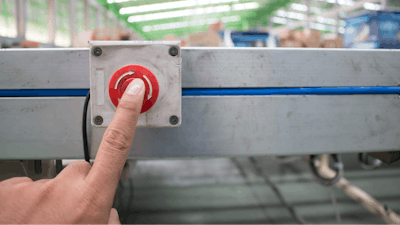
Manufacturing has been hit hard by labor shortages and supply chain disruptions over the past two years. To make up for lost revenue, some companies may be tempted to push their people to do more, working overtime and running shifts at max capacity. In the process these companies may postpone routine plant maintenance to keep up with production.
This can lead to increased risks. Even in highly automated facilities and those that take every precaution, the risk of accidents is never zero. In fact, despite huge advances in workplace safety through OSHA mandates and internal best practices, job site incidents still cost companies an estimated $250 billion a year.
Prioritizing productivity ahead of people is not only costly in terms of injuries (or worse, death), but it can also severely impact retention and recruiting at a time when companies need to do everything they can to avoid losing skilled workers. People want to work for companies that care about their well-being. If safety takes a back seat to productivity, employees will leave. Negative publicity from jobsite accidents can also cause damage to a company’s reputation, making it even harder for them to recruit top talent.
Additionally, with the push toward implementing Environmental, Social and Governance (ESG) initiatives, shareholders and investors are increasingly concerned about employee welfare. The social pillar of ESG focuses on how the business impacts employees, customers and the community, making safety an important component of ESG.
Rather than pushing your people to do more with less, taking a more people-centric approach is the best way to maximize productivity without sacrificing safety. In fact, studies have shown that a healthier workforce is a more productive workforce, which means investing in your employees’ wellbeing can still give you the boost you need to overcome production challenges.
Here are 4 steps manufacturers can take to maximize productivity by focusing on people first.
- Invest in robust preventative maintenance. When you’re short-staffed, it can be easy to overlook routine maintenance, especially if there simply aren’t enough people or time. But this small oversight can result in major expenses, especially if equipment goes down completely or an employee gets hurt. Investing in machinery with a smart interface that tracks conditions such as temperature, vibration and other critical aspects can help staff optimize and extend the life cycle of production equipment by identifying maintenance issues in real-time. It also allows manufacturers to perform cost-effective maintenance before equipment fails or becomes damaged further. In addition to keeping your production machinery well maintained, facility lighting is also a vital piece of equipment. Too often, companies wait until multiple bulbs burn out before mobilizing a maintenance crew, causing visibility to become progressively worse. Poor lighting is a leading cause of trips, slips and falls —the most common causes of lost time accidents.
- Commit to digital transformation. Innovations to industrial equipment and energy management have enabled companies to easily quantify certain metrics, like the amount of energy being saved, the number of accidents avoided, volume of orders delivered, shortened time to market and increased customer satisfaction. Those who prioritize tools with the specific capabilities their facilities currently lack, and have a clear connection to real value opportunities, can fill knowledge gaps throughout the organization. The right technology, customized and adapted to a manufacturing site’s unique circumstances and purpose, can create opportunities for upskilling employees, increased cross-department visibility and collaboration, and better talent recruitment and retention. All of these factors contribute to improving employee skills, satisfaction, and overall workplace safety.
- Routinely collect and analyze data. Despite today’s many technological innovations, many manufacturers still lack visibility into everyday processes that could help them mitigate dangers such as worker safety monitoring and risk analysis. Historically, manufacturers have collected data manually, opening them to human error and recording inaccuracies. This approach is also slow to produce valuable insights since shop-floor data must pass through many hands and be processed manually. With the rapid advancement of industry 4.0 and our connected world, the benefits of routine data collection are multi-faceted. Avoidable downtime and production bottlenecks can be reduced based on reviewing real-time notifications on machines, facility and inventory conditions, and optimizing production processes before accidents occur.
- Foster a culture of strategic collaboration, employee wellness and integration. Workplace collaboration has been proven to make people feel more connected to each other, motivated to work together and be more engaged at work. For manufacturers, pooled knowledge and resources leads to safer facilities, streamlined supply chains, the adaptability to scale up more quickly and efficiently, and quicker delivery times. Concentrating on one particular stage of the process may inadvertently lead to “knowledge silos” within facilities. Treating employees like a number instead of an individual increases stress levels and decreases employee well-being – all factors that contribute to an unhealthy and unsafe work environment.
Investing in workers’ well-being and safety isn’t just an important ESG goal and a recruiting tactic, it’s simply the right thing to do for your people and their families.
Upgrading to long-lasting, industrial-grade technology, like LED lighting or equipment with predictive maintenance and data collection, are a few ways manufacturers can achieve increased safety and reduce maintenance costs. Additionally, improving the safety of employees can bolster your reputation as an employee-centric company who cares about its people.
As a bonus, these steps have also been proven to reduce carbon emissions, lower electricity consumption, and reduce total operating costs, further helping your company reach your ESG goals with sustainability and environmental benefits.
---
Fariyal Khanbabi is the CEO of Dialight.





















